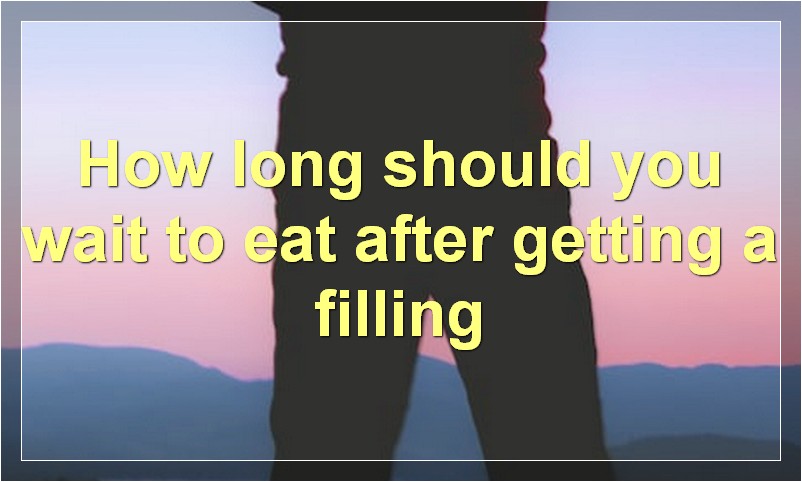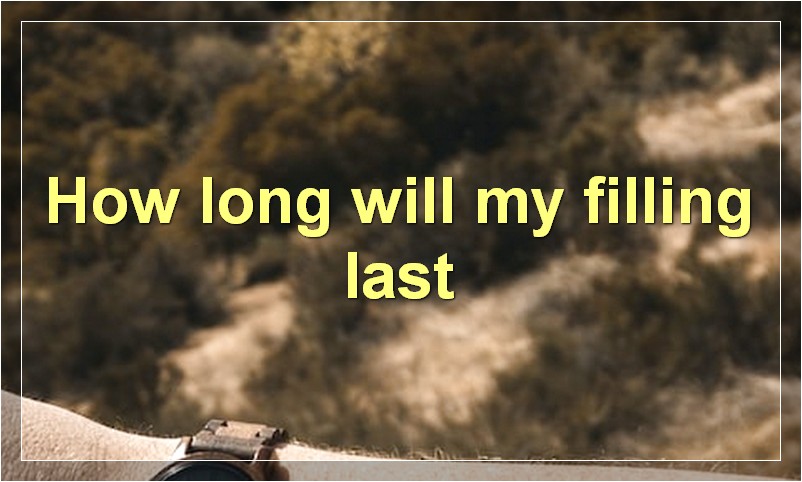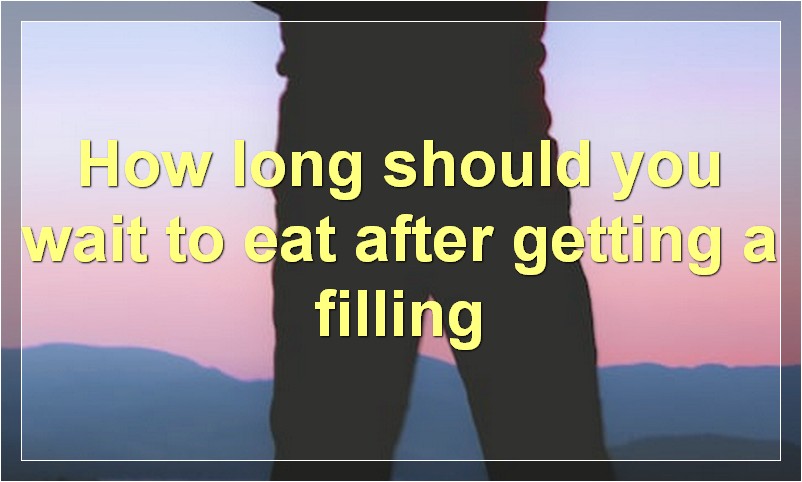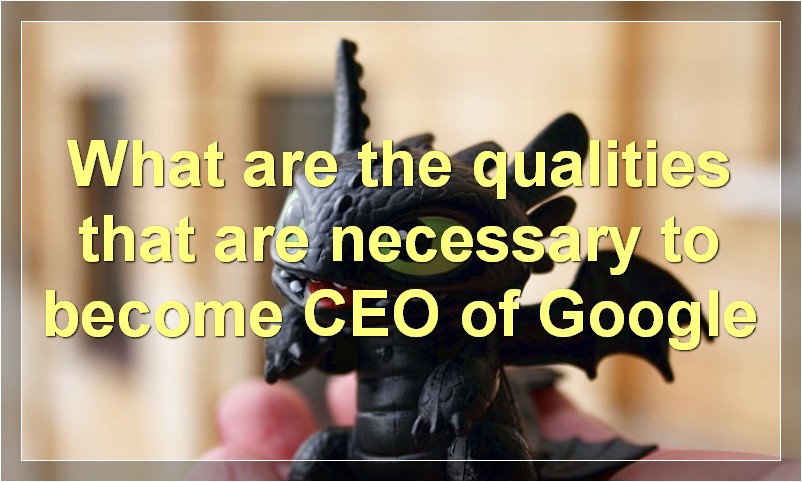You may have heard that you shouldn’t eat for a few hours after getting a filling, but is that really true?
How long should you wait to eat after getting a filling?

You may have heard that you shouldn’t eat for a few hours after getting a filling. The truth is, it isn’t necessary to wait that long before enjoying your favorite foods. In fact, waiting too long to eat can actually cause problems.
Here’s what you need to know about eating and dental fillings:
The Materials Used in Fillings
There are three primary types of materials used in dental fillings: amalgam (silver), composite (tooth-colored), and gold. Amalgam is the most durable type of filling, but it is also the most noticeable. Composite and gold fillings are less noticeable, but they are also less durable.
The type of filling you receive will be based on several factors, including the location of the cavity, the size of the cavity, your insurance coverage, and your personal preference. Your dentist will help you decide which type of filling is right for you.
The Procedure for Getting a Filling
Getting a filling is a relatively simple procedure. First, your dentist will numb the area around the tooth with a local anesthetic. Then, he or she will remove the decayed portion of the tooth using a drill or another type of hand tool.
Once the decay has been removed, your dentist will clean the area and prepare it for the filling material. The filling material will be placed in the cavity and shaped to fit snugly. Finally, the material will be hardened using a special light or laser.
Can I Eat After Getting a Filling?
You don’t have to wait to eat after getting a filling, but you may want to give yourself a few minutes to let the numbing medication wear off. Eating while your mouth is still numb can cause you to bite your tongue or cheek. It’s also important to avoid hard or chewy foods immediately after getting a filling, as they can dislodge the filling material.
If you have any questions or concerns about eating after getting a filling, be sure to ask your dentist. He or she will be happy to offer specific guidance based on your individual situation.
What can you eat after getting a filling?
After getting a filling, you can eat most foods, but it is best to avoid sticky or hard foods for 24 hours. You should also avoid hot or cold drinks for the first few hours after your filling.
How do I know if my filling is ready?
If you’re not sure whether your filling is ready, there are a few things you can do to test it. First, try poking the filling with a toothpick. If the toothpick comes out clean, the filling is probably done. If there’s still batter clinging to the toothpick, put the dish back in the oven and check it again in a few minutes.
Another way to test whether your filling is ready is to touch it lightly with your finger. If the filling feels firm and dry, it’s probably done. If it feels soft or gooey, it needs a little more time in the oven.
Once you’re confident that your filling is cooked through, you can move on to assembling the rest of your dish. If you’re making a pie or tart, for example, you’ll need to add the crust and then bake the whole thing for a bit longer. But if you’re just making a simple baked fruit filling, you can spoon it into a serving dish and enjoy.
What happens if I eat before my filling is ready?
If you’ve ever had a filling, you know that the process is pretty straightforward. First, your dentist numbs your tooth and the surrounding area. Next, they drill out the decay, clean out the area, and then fill it with a composite resin or amalgam. Finally, they polish it off and you’re good to go! It’s important to note that while your tooth is numb, you shouldn’t eat anything until the feeling comes back. Otherwise, you could bite your tongue or cheek without realizing it.
But what happens if you accidentally eat before your filling is ready? Will the filling fall out? Will you get an infection? Here’s what you need to know.
The short answer is no, eating before your filling is ready will not cause any major problems. The filling will not fall out and you’re not likely to get an infection. However, there are a few things to keep in mind.
First, if your tooth is still numb after eating, be careful! You could bite your tongue or cheek without realizing it. Second, if the filling is in a front tooth, you may want to avoid eating until the numbness wears off so you don’t accidentally bite your lip. And finally, be careful with hard or sticky foods. If you bite into something hard, it could dislodge the filling (although this is unlikely). And if you eat something sticky, like caramel or gum, it could pull the filling out entirely. So it’s best to avoid those types of foods until the numbness goes away.
In general, eating before your filling is ready isn’t a big deal. But it’s important to be careful until the numbness wears off completely.
How long will my filling last?

Dental fillings are not intended to be a permanent fix for your teeth. In fact, most fillings only last between 5 and 10 years before they need to be replaced. However, there are some factors that can affect how long your filling will last. Here are a few things to keep in mind:
The type of filling: There are two main types of dental fillings – amalgam and composite. Amalgam fillings, which are made of metal, are typically more durable than composite fillings. However, composite fillings are less noticeable and can be matched to the color of your teeth.
The location of the filling: Fillings that are located in high-stress areas, such as the back molars, tend to wear down more quickly and may need to be replaced sooner than other types of fillings.
Your oral hygiene habits: Good oral hygiene habits, such as brushing twice a day and flossing daily, can help extend the life of your dental fillings.
If you have any concerns about the longevity of your dental fillings, be sure to talk to your dentist. They can evaluate your fillings and make recommendations for replacement, if necessary.
How often do I need to get a filling?
How often do I need to get a filling? This is a question that many people have, but few know the answer to. The truth is, it depends on a number of factors. Here are a few things that will affect how often you need to get a filling:
1. The type of tooth you have: Some teeth are more prone to decay than others. If you have a molar (back tooth), you’re more likely to need a filling than if you have a incisor (front tooth). This is because molars have more pits and fissures (grooves) on their surface, which can trap food and bacteria.
2. Your diet: A diet high in sugar can contribute to cavities. If you eat sugary foods often, you’re more likely to need a filling than someone who doesn’t.
3. Your oral hygiene: Good oral hygiene habits (brushing twice a day, flossing daily, etc.) can help prevent cavities. If you don’t take care of your teeth, you’re more likely to need a filling.
4. Your medical history: Some medical conditions can increase your risk for cavities. For example, if you have diabetes, you’re more likely to develop cavities because of the high levels of sugar in your blood.
5. Your age: Children and seniors are more likely to need fillings because their teeth are more susceptible to decay.
If you’re concerned about how often you need to get a filling, talk to your dentist. They can assess your individual risk factors and give you an idea of how often you should have your teeth checked for cavities.
What are the signs that I need a filling?
Most of us have had a filling at some point in our lives. A filling is a way to restore a tooth that has been damaged by decay back to its normal function and shape. When a dentist gives you a filling, they’re actually doing two things:
First, they’re removing the part of the tooth that has been damaged by decay. This is done with a drill (yup, the same kind of drill that you might see at the dentist’s office!) and it can be a little bit noisy and uncomfortable.
Once the decayed part of the tooth has been removed, the dentist will then fill the tooth with a material that will restore it to its original shape and function. There are several different types of materials that can be used for fillings, but the most common type is called amalgam. Amalgam is made up of different metals, including mercury, silver, tin, and copper.
So now that we know what a filling is and what it does, let’s talk about the signs that you might need one.
The most obvious sign that you need a filling is if you have a cavity. Cavities are small holes in your teeth that are caused by decay. If you think you might have a cavity, it’s important to see your dentist as soon as possible so they can treat it before it gets worse.
Another sign that you might need a filling is if you have tooth pain. This can be anything from a sharp pain when you bite down to a more general feeling of discomfort. If you have tooth pain, it’s important to see your dentist so they can determine the cause and provide treatment.
You might also need a filling if you have Sensitivity to hot or cold temperatures: If your teeth are sensitive to hot or cold temperatures, it could be a sign that you have a cavity. If you notice this symptom, it’s best to see your dentist so they can take a look and determine whether or not you need a filling.
Finally, another sign that you might need a filling is if you see visible holes in your teeth. If you notice any holes in your teeth, it’s important to see your dentist right away so they can determine whether or not you need a filling.
If you think you might need a filling, the best thing to do is schedule an appointment with your dentist. They will be able to take a closer look at your teeth and determine whether or not you need treatment.
What causes fillings to fall out?
Dental fillings are designed to last many years, but eventually they will need to be replaced. There are several reasons why a filling might fall out:
1. Decay – over time, the tooth decay that originally caused the need for a filling can continue to weaken the tooth, and eventually the filling can no longer support the tooth.
2. Fracture – a tooth that has been filled is more likely to fracture than an unfilled tooth, so if you have a history of dental fractures you may be more likely to lose a filling.
3. Grinding – teeth grinding (bruxism) can put extra stress on teeth and cause fillings to loosen and fall out.
4. Poor fit – if a filling is not properly fitted, it is more likely to come loose. This can happen if the filling is too big or too small, or if it was not placed correctly in the first place.
5. Gum disease – gum disease can cause the supporting tissues around teeth to break down, which can lead to fillings falling out.
If you have a filling that has fallen out, it is important to see your dentist as soon as possible. A new filling will need to be placed to protect the tooth from further decay or damage.
How can I avoid needing fillings?
Dental fillings are a necessary evil in many people’s lives. But they don’t have to be! There are plenty of things you can do to avoid needing those pesky fillings. Here are a few tips:
1. Brush and floss regularly. This one is a no-brainer. By keeping your teeth clean, you’re less likely to develop cavities in the first place. So brush twice a day for two minutes each time, and floss once a day.
2. Eat healthy foods. A diet rich in sugary and starchy foods is more likely to cause cavities than a diet full of healthy fruits, vegetables, and proteins. So cut back on the candy and chips, and load up on the good stuff.
3. Limit acidic drinks. Soft drinks, sports drinks, and even fruit juices can be acidic and damage tooth enamel. So drink them in moderation, and rinse your mouth out with water afterwards.
4. Don’t smoke. Smoking is terrible for your teeth (and your overall health). It increases your risk of gum disease and tooth decay. So quit now!
5. See your dentist regularly. Even if you’re taking good care of your teeth at home, it’s important to see your dentist for regular checkups and cleanings. They can spot problems early and help you keep your smile healthy.




